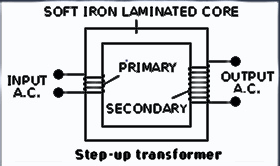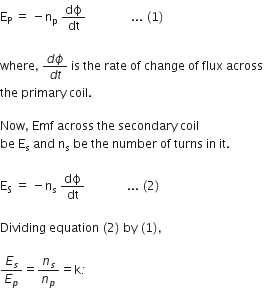Draw a necessary arrangement for winding of primary and secondary coils in a step-up transformer. State its underlying principle and derive the relation between the primary and secondary voltages in terms of number of primary and secondary turns. Mention the two basic assumptions used in obtaining the above relation.
State any two causes of energy loss in actual transformers.
Underlying principle of a step-up transformer: A transformer which increases the ac voltage is known as a step up transformer.
Working of step-up transformer is based on the principle of mutual inductance and it converts the alternating low voltage to alternating high voltage. The number of turns in the secondary coil is greater than the number of turns in the primary coil.
i.e., NS > NP

Working: When an A.C source is connected to the ends of the primary coil, the current changes continuously in the primary coil. Hence, the magnetic flux which is linked with the secondary coil changes continuously. So, the emf which is developed across the secondary coil is same as that in the primary coil. The emf is induced in the coil as per Faraday’s law.
Let, EP be the alternating emf applied to primary coil and np be the number of turns in it.
Consider ![]() as the electric flux associated with it.
as the electric flux associated with it.
Then, 
Assumption: We assume that there is no leakage of flux so that, the flux linked with each turn of primary coil is same as flux linked with secondary coil.
Two sources of energy loss in the transformer:
Joule Heating – Energy is lost in resistance of primary and secondary windings in the form of heat.
H = I2Rt
Flux leakage - Energy is lost due to coupling of primary and secondary coils not being perfect, i.e., whole of magnetic flux generated in primary coil is not linked with the secondary coil.
iii)
Conservation of law of energy is not violated in step-up transformer. When output voltage increases, the output current automatically decreases. Thus, there is no loss of energy.
